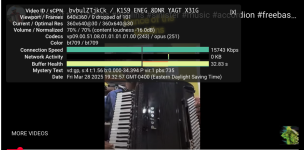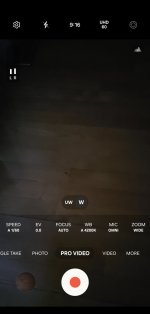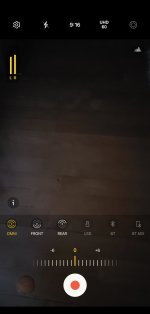breezybellows
Well-known member
I'm as lazy as they come when it comes to recording.
All of us would agree that recording using the smart phone's microphone is a big compromise in sound quality. It's convenient to shoot trim and upload using one device.
I've been slowly doing my toes into improving my audio set up.
This was the set up I've used for the last year or so (when I feel like I want better sound).
Zoom H6 as a audio interface.
Harmonic AC 5001 HQ internal microphones on my accordion.
Accordion to Zoom H6 using instrument cable.
Connect Zoom H6 to Google pixel 5 using USB C cable.
Phone's stock camera detects zoom h6. Record audio and video together.
Copy video file to MacBook (using Android file transfer).
Adjust eq and add some reverb using logic pro.
Copy audio file back to phone.
Add edited audio to video using video editing app (power director)
Upload to YouTube.
That is such a pain. Why does it have to be so hard!
I broke my audio interface!
I dropped it and then it stopped working.
I wanted to buy a new one. Before that I wanted to read a bit more about audio set up. So I asked chatGPT some questions and I watched some YouTube videos.
Some members from this forum have suggested that I need to record the audio directly into the zoom recorder.
These were the changes I made to my sound set up.
1) New Audio Interface Zoom H6Essential
I read about 32 bit float recording format. Its supposed to avoid clipping (when I set the gain too high on the pre amp). I also read that it's not really necessary if you do the gain set correctly. Also the signal to noise ratio on the Harmonik mics were not high enough for 24 bit encoding to be a bottleneck. It looked like 32 bit float can help in some cases and its good to have when you set the gain incorrectly. So I went ahead and bought it.
2) Record as wav file directly to zoom recording device
I recorded the video on my phone and the audio was recorded onto the zoom H6Essential
3) DAW on phone
My pixel 5 died after 5 years. I bough a new pixel 9 pro fold. The bigger screen is convenient enough to do audio editing on the phone. I installed the lighter version of cubase. Now I don't have to copy the files onto the macbook. I copy the audio from the zoom recorder to my phone.
The results:
1) I think they sound significantly better. The sound seems very clear. Not sure how much of this can be attributed to the 32 bit float recording. I'm guessing most of the improvement is because of recording as a wav file directly onto the zoom recorder.
2) Cubase has some interesting presets for EQ and reverb. The process is pretty quick.
Note: I have some AKG C-414 mics that will probably sound better. But I'll need to have a quiet room in order to use that.
All of us would agree that recording using the smart phone's microphone is a big compromise in sound quality. It's convenient to shoot trim and upload using one device.
I've been slowly doing my toes into improving my audio set up.
This was the set up I've used for the last year or so (when I feel like I want better sound).
Zoom H6 as a audio interface.
Harmonic AC 5001 HQ internal microphones on my accordion.
Accordion to Zoom H6 using instrument cable.
Connect Zoom H6 to Google pixel 5 using USB C cable.
Phone's stock camera detects zoom h6. Record audio and video together.
Copy video file to MacBook (using Android file transfer).
Adjust eq and add some reverb using logic pro.
Copy audio file back to phone.
Add edited audio to video using video editing app (power director)
Upload to YouTube.
That is such a pain. Why does it have to be so hard!
I broke my audio interface!
I dropped it and then it stopped working.
I wanted to buy a new one. Before that I wanted to read a bit more about audio set up. So I asked chatGPT some questions and I watched some YouTube videos.
Some members from this forum have suggested that I need to record the audio directly into the zoom recorder.
These were the changes I made to my sound set up.
1) New Audio Interface Zoom H6Essential
I read about 32 bit float recording format. Its supposed to avoid clipping (when I set the gain too high on the pre amp). I also read that it's not really necessary if you do the gain set correctly. Also the signal to noise ratio on the Harmonik mics were not high enough for 24 bit encoding to be a bottleneck. It looked like 32 bit float can help in some cases and its good to have when you set the gain incorrectly. So I went ahead and bought it.
2) Record as wav file directly to zoom recording device
I recorded the video on my phone and the audio was recorded onto the zoom H6Essential
3) DAW on phone
My pixel 5 died after 5 years. I bough a new pixel 9 pro fold. The bigger screen is convenient enough to do audio editing on the phone. I installed the lighter version of cubase. Now I don't have to copy the files onto the macbook. I copy the audio from the zoom recorder to my phone.
The results:
1) I think they sound significantly better. The sound seems very clear. Not sure how much of this can be attributed to the 32 bit float recording. I'm guessing most of the improvement is because of recording as a wav file directly onto the zoom recorder.
2) Cubase has some interesting presets for EQ and reverb. The process is pretty quick.
Note: I have some AKG C-414 mics that will probably sound better. But I'll need to have a quiet room in order to use that.



